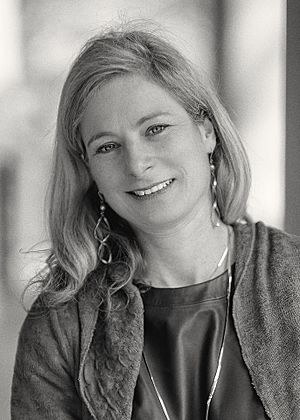Lisa Randall facts for kids
Quick facts for kids
Lisa Randall
HonFInstP
|
|
|---|---|

Randall in 2015
|
|
| Born | June 18, 1962 Queens, New York City, U.S.
|
| Alma mater | Harvard University (BA, PhD) |
| Known for | Randall–Sundrum model Warped Passages (2005) |
| Relatives | Dana Randall (sister) |
| Awards | Klopsteg Memorial Award (2006) Lilienfeld Prize (2007) Andrew Gemant Award (2012) Sakurai Prize (2019) Oskar Klein Medal (2019) |
| Scientific career | |
| Fields | Physics |
| Institutions | Lawrence Berkeley Laboratory University of California, Berkeley Princeton University Massachusetts Institute of Technology Harvard University |
| Doctoral advisor | Howard Georgi |
| Doctoral students |
|
Lisa Randall is a famous American theoretical physicist. She was born on June 18, 1962. She is a professor at Harvard University.
Dr. Randall studies the basic rules of nature. She explores ideas like extra dimensions of space. She also looks into the Standard Model of particle physics. This model describes the smallest particles and forces.
Her work includes supersymmetry, which suggests new particles exist. She also studies dark matter, a mysterious substance in the universe. She helped create the Randall–Sundrum model in 1999. This model explores how gravity might be weaker than other forces.
Contents
Early Life and School
Lisa Randall grew up in Queens, New York City. Her mom was a teacher, and her dad was an engineer. She went to Stuyvesant High School. Another famous physicist, Brian Greene, was her classmate there.
In 1980, when she was 18, she won first place in the Westinghouse Science Talent Search. She also earned a National Merit Scholarship. She then went to Harvard University. She earned her first degree in physics in 1983. She completed her PhD in theoretical particle physics in 1987. Her advisor was Howard Georgi.
Lisa Randall's Work in Physics
Dr. Randall is a professor of theoretical physics at Harvard. She studies tiny particles and the basic forces that hold everything together. Her research often involves ideas about extra dimensions.
She has also worked on supersymmetry. This is a theory that suggests every known particle has a heavier "superpartner." She also studies cosmological inflation. This is a theory about how the universe expanded very quickly after the Big Bang.
After her PhD, Dr. Randall taught at MIT and Princeton University. She returned to Harvard in 2001. She was the first woman to become a tenured professor in Princeton's physics department. She was also the first tenured female theoretical physicist at Harvard.
Dr. Randall is a member of several important science groups. These include the American Academy of Arts and Sciences. She is also part of the United States National Academy of Sciences. She helps organize many science conferences. She has also been on the boards of top physics journals.
Sharing Science with Everyone
Lisa Randall has written popular science books. These books help explain complex physics ideas to a wider audience. Her book Warped Passages: Unraveling the Mysteries of the Universe's Hidden Dimensions was very popular. It explored the idea of hidden dimensions.
Another book, Knocking on Heaven’s Door: How Physics and Scientific Thinking Illuminate the Universe and the Modern World, was also a bestseller. This book talked about the search for the Higgs boson. The Higgs boson is a particle that gives other particles mass.
Scientists at the Large Hadron Collider found the Higgs boson in 2012. This was a huge discovery in physics. Dr. Randall said it was exciting that people cared about this new finding. She also wrote an e-book called Higgs Discovery: The Power of Empty Space.
Before the Large Hadron Collider started, some people worried it might create black holes. Dr. Randall explained that this was not possible. She said it would only happen if space and gravity were very different from what we know.
Dr. Randall also wrote the story for an opera. The composer, Hèctor Parra, was inspired by her book Warped Passages. The opera is called Hypermusic Prologue: A Projective Opera in Seven Planes.
Awards and Special Honors
Lisa Randall has received many awards for her work. In 2004, she was one of the most cited theoretical physicists. This means many other scientists referred to her work.
In 2005, Seed magazine called her a "Year in Science Icon." Newsweek also named her "one of the most promising theoretical physicists." In 2007, Time magazine included her in their "Time 100" list. This list features the 100 most influential people in the world.
Other awards she has received include:
- J.J. Sakurai Prize for Theoretical Particle Physics in 2019
- Andrew Gemant Award in 2012
- Golden Plate Award from the American Academy of Achievement in 2008
- Lilienfeld Prize in 2007
- E. A. Wood Science Writing Award in 2007
- Klopsteg Memorial Award from the American Association of Physics Teachers in 2006
- Premio Caterina Tomassoni e Felice Pietro Chisesi from the Sapienza University of Rome in 2003
- National Science Foundation Young Investigator Award in 1992
Personal Life and Hobbies
Lisa Randall has a sister named Dana Randall. Dana is a professor of computer science at Georgia Tech.
Lisa Randall loves to climb rocks. There is even a rock face in Colorado named "Lisa Randall Wall" after her. This shows how much she enjoys climbing.
See also
 In Spanish: Lisa Randall para niños
In Spanish: Lisa Randall para niños

